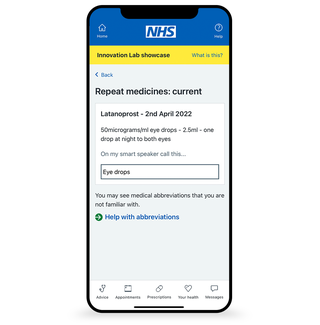Voice as a Channel prototype
What are the opportunities for citizens to interact with the NHS using smart speakers and their voices?
What was the problem?
Over recent years, voice-activated smart speakers have become increasingly commonplace in UK homes – rising from 20% of households in 2019 to 50% in 2021.
So far, the NHS in England has explored how general health and symptom advice might be made available to the public through voice assistants by syndicating content from nhs.uk, but has yet to explore the opportunities of using voice as a channel for transactional services, alongside the web (nhs.uk) and the NHS App.
We wanted to understand the opportunities that voice presents, how to implement it successfully, potential effective use cases, benefits, risks, and other considerations.
What could be the benefit of improving this?
For the NHS
- Better understanding of the current marketplace, capabilities and opportunities offered by voice assistant technology, for the benefit of NHS staff involved in developing national, regional and local services
- Better understanding of how users interact with voice assistants, their needs, and the types of tasks that voice assistant interfaces might be suited to
- Avoiding resources being wasted on projects which aren’t well suited to voice
For people who use the NHS
- Providing access to services in a way which suits their lifestyle, technology and specific situations
- Making platforms more accessible to people who are blind, partially sighted, have limited mobility, cognitive disabilities, low literacy or low digital skills
Our hypothesis
We believe that transactional voice-activated command capabilities could offer considerable opportunities for users, particularly those facing digital exclusion or accessibility challenges, and building a robust understanding of these opportunities will enable the NHS to utilise it more effectively.
What did we do?
Working with experience design consultancy CX Partners, we:
- did desk research to understand the industry landscape and technical capabilities of voice-assistant platforms;
- did user research with 32 citizens from a wide range of backgrounds and experiences (age, gender, location, ethnicity, socio-economic background, usage of the NHS, and experience of using voice technology), as well as with clinicians and charities;
- built several prototypes with varying degrees of fidelity, and tested them with users;
- explored multi-modal user journeys, for example giving a prescription a meaningful nickname in the NHS App (such as “eye drops”), and then using that nickname when talking to the smart speaker
- engaged with the tech companies behind the most popular voice-assistant platforms.

What did we learn?
- Voice technology could help improve access to healthcare in England for the:
- 8.5m people with low literacy
- 6.3m people with dyslexia
- 1m people with a tremor (and others with low mobility)
- 2m people with sight loss
- Just under 1m people who don’t read/write English fluently
- Generally, speaking is quicker than typing, but listening is slower than reading – which means voice works well in situations where users are providing information rather than consuming it
- Using your voice to complete tasks involves a large behaviour shift and isn’t always intuitive or discoverable
- The best use cases involved simple, short interactions which a user does frequently such as ordering repeat prescriptions or submitting blood pressure measurements
- The boundaries between platform and application were not clear to many of the people we spoke to – they had strong concerns about who has access to their health data and what it might be used for, especially with large international technology companies owning the voice platforms
- The accuracy of recognition, particularly of the names of medicines and medical conditions was not always reliable, especially for those with conditions affecting their speech or those who had strong regional or international accents
- The API-based architecture of many NHS services would aid their implementation on voice platforms
- An interface designed specifically for voice is different from a web page or app using voice-based assistive technologies built into device operating systems. These read on-screen text out loud, rather than providing an optimised voice experience, meaning some people find them frustrating to use
- Multiple users and smart speakers in communal settings require careful design of the processes of verifying and authenticating account holders, identifying who is speaking, authorising transactions, and ensuring information is not inappropriately disclosed
More information
If you would like to talk to us about this project, you can contact us at england.innovation.lab@nhs.net
About the NHS Innovation Lab
The NHS Innovation Lab was established to develop and test novel solutions to challenges facing the health and social care systems. Using innovative thinking and user-centred design processes, between 2020 and 2023 it explored dozens of problems across many different areas which, if solved, had the potential for substantial impact for patients, staff and organisations.